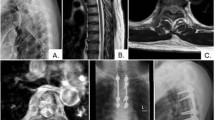Abstract
Metastatic spinal cord compression (MSCC) is a serious complication of metastatic prostate cancer (PCa). This study retrospectively evaluated patients who presented with paraplegia or quadriplegia because of MSCC of PCa. Of 847 patients with PCa who were treated between 1989 and 1998, 26 (3.1%) demonstrated paraplegia or quadriplegia because of MSCC. Characteristics, treatment efficacy, and prognosis of these patients were analyzed. In total, 15 cases became paraplegic despite androgen ablation therapy (Group I). Average time to paraplegia from initial hormonal treatment was 34 months. Out of nine cases who underwent radiation therapy (RT) to spinal lesions with/without chemotherapy, one patient became ambulatory. However, this patient subsequently had recurrent compression. Two cases had remission of paralysis. Two cases underwent laminectomy plus RT and in one case paralysis improved. MSCC was the first indication of PCa in 11 cases (Group II). Two cases underwent laminectomy plus hormone therapy and nine cases underwent hormone therapy alone. Four patients became ambulatory and two cases showed improved motor capacity. Average interval from paraplegia to death was 7.4 months in Group I and 27.1 months in Group II. However, there was no statistical difference in these two groups on disease-specific survival from the start of initial treatment. It is difficult to recover the ability to walk if paraplegia or quadriplegia occurs in PCa patients although decompression surgery plus hormone therapy seemed to impair the prognosis. Stage M1 patients with paraplegia had survival rates as good as stage M1 patients without paralysis. This should encourage an aggressive treatment approach. However, for patients with hormone-independent disease there seems to be no effective treatment and prognosis is poor.
This is a preview of subscription content, access via your institution
Access options
Subscribe to this journal
Receive 4 print issues and online access
$259.00 per year
only $64.75 per issue
Buy this article
- Purchase on Springer Link
- Instant access to full article PDF
Prices may be subject to local taxes which are calculated during checkout


Similar content being viewed by others
References
Drew M, Dickson RB . Osseous complications of malignancy. In: Lokich JJ (ed). Clinical Cancer Medicine: Treatment Tactics. MTP Press: Boston, 1980, pp 97–124.
Arnheim FK . Carcinoma of the prostate: a study of the postmortem findings in one hundred and seventy-six cases. J Urol 1948; 60: 599–603.
Jacobs SC . Spread of prostatic cancer to bone. Urology 1983; 21: 337–344.
Schaberg J, Gainor BJ . A profile of metastatic carcinoma of the spine. Spine 1985; 10: 19–20.
Kuban DA et al. Characteristics of spinal cord compression in adenocarcinoma of prostate. Urology 1986; 28: 364–369.
Sobin JH, Wittekind C . International Union Against Cancer: TNM Classification of Management of Tumours, 5th edn. Wiley, New York, 1997.
Soloway MS et al. Stratification of patients with metastatic prostate cancer based on extent of disease on initial bone scan. Cancer 1988; 61: 195–202.
Smith EM et al. Spinal cord compression secondary to prostate carcinoma: treatment and prognosis. J Urol 1993; 149: 330–333.
Asdourian PL . Metastatic disease of the spine. In: Bridwell KH, DeWald RL (eds) The Textbook of Spinal Surgery, 2nd edn, Vol. 2. Lippincott-Raven, Philadelphia, 1997, pp 2007–2050.
Harrington KD . Anterior cord decompression and spinal stabilization for patients with metastatic lesions of the spine. J Neurosurg 1984; 61: 107–117.
Boland PJ, Lane JM, Sundaresan N . Metastatic disease of the spine. Clin Orthop 1982; 169: 95–102.
Siegal T . Current considerations in the management of neoplastic spinal cord compression. Spine 1989; 14: 223–228.
Cook GB, Watson FR . Events in the natural history of prostate cancer: using salvage curves, mean age distributions and contingency coefficients. J Urol 1968; 99: 87–96.
Zelefsky MJ et al. Spinal epidural tumor in patients with prostate cancer. Clinical and radiographic predictors of response to radiation therapy. Cancer 1992; 70: 2319–2325.
Shoskes DA, Perrin RG . The role of surgical management for symptomatic spinal cord compression in patients with metastatic prostate cancer. J Urol 1989; 142: 337–339.
Cybulski GR, Von Roenn KA, D'Angelo CM, DeWald RL . Luque rod stabilization for metastatic disease of the spine. Surg Neurol 1987; 28: 277–283.
Harrington KD . Anterior decompression and stabilization of the spine as a treatment for vertebral collapse and spinal cord compression from metastatic malignancy. Clin Orthop 1988; 233: 177–197.
Hammerberg KW . Surgical treatment of metastatic spine disease. Spine 1992; 17: 1148–1153.
Phillips E, Levine AM . Metastatic lesions of the upper cervical spine. Spine 1989; 14: 1071–1077.
O'Neil J, Gardner V, Armstrong G . Treatment of tumors of the thoracic and lumbar spinal column. Clin Orthop 1988; 227: 103–112.
Lee CK, Rosa R, Fernand R . Surgical treatment of tumors of the spine. Spine 1986; 11: 201–208.
Maranzano E, Latini P . Effectiveness of radiation therapy without surgery in metastatic spinal cord compression: final results from a prospective trial. Int J Radiat Oncol Biol Phys 1995; 32: 959–967.
Author information
Authors and Affiliations
Corresponding author
Additional information
Grant sponsor: Japan Society for the Promotion of Science; Grant numbers: Grant-in-Aid for Scientific Research (C2) 14571483.
Rights and permissions
About this article
Cite this article
Nagata, M., Ueda, T., Komiya, A. et al. Treatment and prognosis of patients with paraplegia or quadriplegia because of metastatic spinal cord compression in prostate cancer. Prostate Cancer Prostatic Dis 6, 169–173 (2003). https://doi.org/10.1038/sj.pcan.4500641
Received:
Accepted:
Published:
Issue Date:
DOI: https://doi.org/10.1038/sj.pcan.4500641
Keywords
This article is cited by
-
Rolle der Strahlentherapie bei onkologischen Notfällen
Der Onkologe (2020)
-
Hormonal therapy with external radiation therapy for metastatic spinal cord compression from newly diagnosed prostate cancer
Journal of Orthopaedic Science (2013)
-
Strahlentherapeutische Interventionen bei onkologischen Notfällen
Der Onkologe (2010)
-
Palliative und supportive Therapie bei Patienten mit fortgeschrittenem Prostatakarzinom
Der Urologe (2007)



